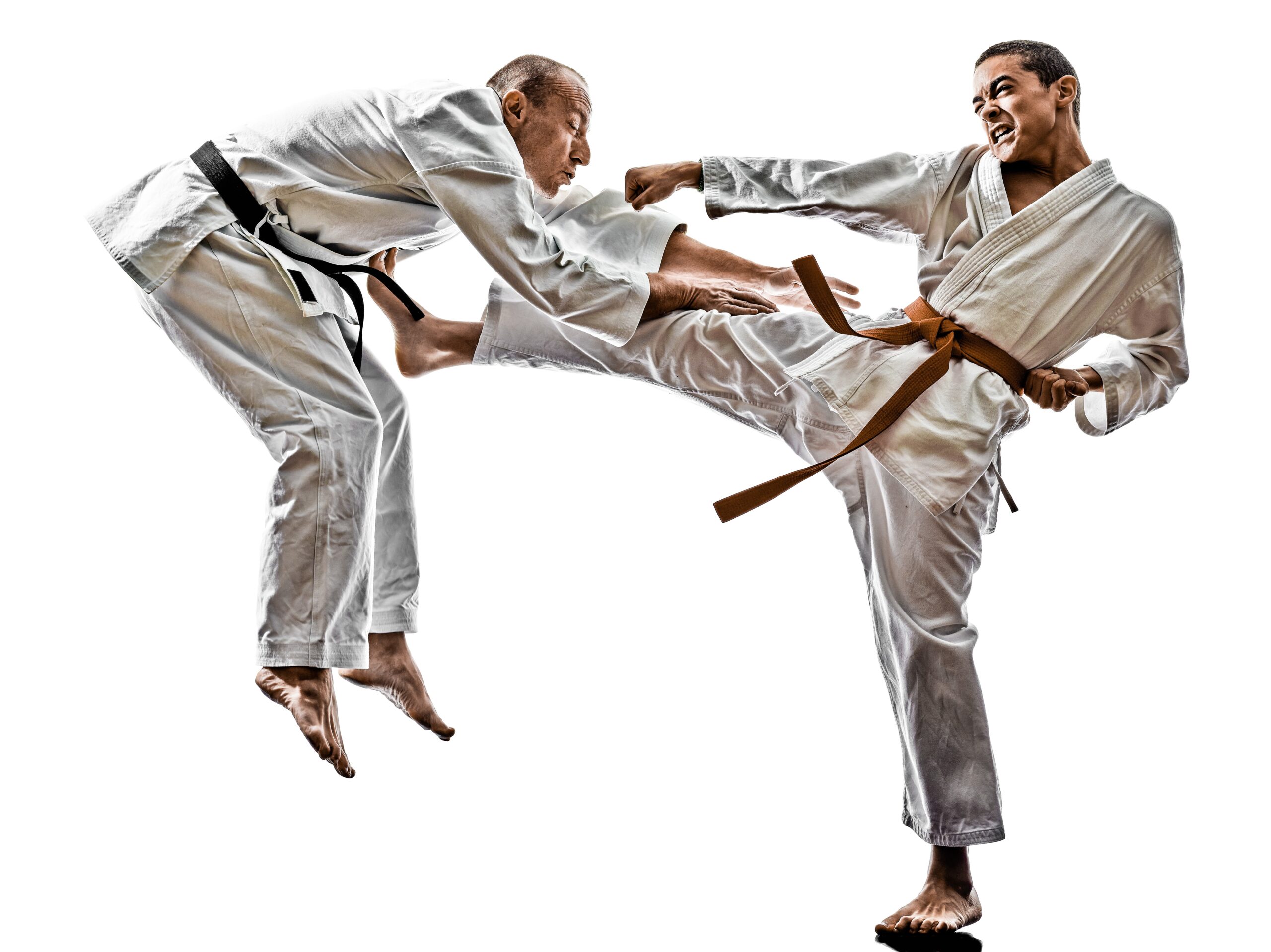Combat Arts Abdomen Injuries Overview

Abdomen injuries can be quite dangerous. The reason is that sometimes these injuries do not develop any symptoms until much later. UFC middleweight champion Robert Whittaker developed an abdominal injury through training. He’s not sure when but he only felt bloated initially. Hours later, he developed chronic vomiting. His bowel collapsed and he had an internal hernia of the intestine. Doctors assumed he’s had the hernia for a while after years of abdominal trauma.
Causes of Abdomen Injury
The abdomen is vulnerable because it does not have any bones to protect it. With layers of muscles, tendons, and soft tissue, major organs and blood vessels lie right below the surface. The abdomen is injured during flying knee kicks, punches, and blocking moves. The mechanism of injury in the abdomen is diverse.
This could be due to blunt force, penetrating injuries by a weapon, deceleration injuries, hemorrhage, or hematomas. Organ crush injuries are also seen during excessive force, chemical peritonitis, hernias, and infection are some other injuries and their sequelae. The organs that are often damaged in the abdomen are liver, spleen, intestines, stomach, pancreas, kidneys, and the abdominal wall. Full combat MMA sports tend to cause many abdominal injuries.
Abdomen Injury Symptoms



Types of Abdomen Injuries
There are a variety of injuries that occur due to the multiple organs in the abdomen. These injuries could be classified based on the mechanism of injury or based on the organ involved. Repeated trauma also weakens the abdominal wall. The abdominal wall can face acute trauma or gradual degenerative injuries. These include injuries to the liver, spleen, kidney, bowel and stomach injuries, and abdominal wall.
Strong Abdominals Are a Sign of a Strong Combat Athlete
Improve Your Muscle Strength With Us!
Abdomen Specific Injuries
The liver is a large organ that is vulnerable as it protrudes from under the ribcage. Manny MMA sports have specific moves that target the liver specifically, the liver shot or the liver punch. In this move, the liver is repeatedly punched, kicked, or struck.
Due to its large size, its often injured via blunt force or penetrating injury. Liver injuries can range from a minor laceration to complete avulsion. Take the case of Jason DeLuca. During the 1996 Pancrase fight, MMA legend Bas Rutten repeatedly hammered DeLuca with liver punches that ended with him rupturing DeLuca’s liver.
Symptoms
Causes
The liver is injured easily due to its anterior location. Its parenchyma is fragile and the Gleeson’s capsule is thin and easily violated. There are two ways to injure the liver in MMA. One is via a deceleration injury. The other is via a direct blow through moves directed at the liver area. Deceleration is when the liver and its capsule gets sheared as it continues to move while the rest of the body undergoes sudden deceleration. Direct blows cause hematomas or crush injuries to the liver.
To learn how Liver Injuries is diagnosed Click Here
This is the most injured abdominal organ in combat sports. The injuries can occur both due to blunt and penetrating mechanisms. Displaced rib fractures can also rupture the spleen. Most of these injuries occur due to accidental injuries rather than an intentional kick or punch.
Symptoms
Causes
Traumatic injury to the spleen usually occurs due to blunt force trauma during a punch or a kick. A sudden deceleration can also cause the spleen to shear as it continues to moves while the body suddenly stops. Overlying fractured ribs can also penetrate the spleen. The shear or injury can occur in the capsule covering the spleen, the area below the capsule, the hilar blood vessels, or the soft tissue of the spleen itself.
To learn how Splenic Injury is diagnosed Click Here
Specific moves like kidney strikes are legal in the MMA. However, the kidneys have a limited capacity to heal. Over time, kidney strikes can damage the nephrons and microvessels. The damage is permanent. Additionally, training too hard can cause muscles to break down leading to a condition called rhabdomyolysis. This can clog the kidneys and further deteriorate the kidney function. MMA fighter Brian Melancon experienced something similar. His kidney function had dropped to 47% at the peak of his career and it ended his career. Apart from the muscle and direct renal blows, dehydration can also adversely affect the kidneys.
In MMA, the kidney punch or kidney strike is a localized strike above one of the two kidneys. It’s a powerful shot, though controversial. It can be done while grappling or stand up fighting. In many competitions, it isn’t allowed. However, unintentional kidney punches occur when you open up that area at the last moment and the kidney is exposed. Any strain on the kidney through dehydration and rhabdomyolysis will further worsen this injury. Any crushing of the kidneys against the paravertebral muscles or rapid deceleration forces can also cause renal injury. Rapid deceleration causes avulsion at the ureteropelvic junction and the avulsion of the renal blood vessels.
To learn how Renal Injury are diagnosed Click Here
Abdominal kicks are common in BJJ. However, these kicks and punches have unseen and adverse effects. Cases have been reported of blunt abdominal trauma causing ischemic colitis. Brock Lesnar, also retired from MMA fighting after repeated bouts of diverticulitis that worsened after every fight. In his case, 12 inches of his colon had to be surgically removed.
Blunt abdominal trauma can damage the bowel and stomach resulting in internal bleeding. The mechanism is via direct trauma through a kick or punch. The problem with this injury is that the signs and symptoms present much later. Most fighters continue to play despite the injury with the aid of pain killers. Bowel injuries can include transient ischemia to the bowels, hematomas, cecal slap syndrome, and runner’s trots. These are diverse injuries ranging from serious to mild.
To learn how Bowel And Stomach Injuries are diagnosed Click Here
In fighters whose core muscles are weak, it is easy to develop a hernia or injury easily following trauma. The abdominal wall is made up of four layers of muscles, rectus abdominis, external oblique, internal oblique, and the transverse abdominis muscle. These muscles can weaken due to repeated stress leading to a hernia. Direct trauma can also injure the abdominal wall.
Direct trauma from a punch, kick, or repeated punches and kicks can injure the abdominal wall. Also, sudden violent contraction of the muscle due to abrupt torso movement seen in many grappling moves can affect the abdominal wall. These injuries could be rectus sheath hematomas or contusions to the underlying muscles.
To learn how Abdominal Wall Injuries are diagnosed Click Here



Common Abdomen Injuries
Read about common abdominal injuries like abdominal blunt force trauma and laceration in our Common Injuries section.
Abdomen Injury Diagnosis
The diagnosis of abdominal injuries takes place ringside. Since symptoms take time to develop, it’s important to identify abdominal trauma and then transfer to the hospital immediately to determine what organ is injured. A variety of tests are required to confirm organ damage and the extent of the damage.
Injury Specific Diagnosis
Physical Exam
The doctor will first examine and check for signs of hypovolemia and blood loss. A narrow pulse pressure, low blood pressure, and increased heart rate. A thorough abdominal exam is done. If there is guarding of the abdomen, board like rigidity, or other peritoneal signs, it’s an indication of a larger injury within the abdomen. The doctor will look for signs of liver injury like right upper quadrant tenderness and abdominal distention. The presence of these signs indicates blood is pooling within the abdomen.
Imaging
The first and quickest test to check for liver injury is the focused assessment with sonography for trauma (FAST) exam. The FAST exam identifies the presence of blood in the abdominal cavity. It cannot tell the degree of liver injury. If the fighter’s blood pressure and pulse are stable, then a CT scan of the abdomen and pelvis with intravenous (IV) contrast is done. It is the gold standard for hepatic injuries. CT can identify hepatic injury and grade the severity of the injury. It can confirm other abdominal injuries and quantify how much blood is pooling in the abdomen. IV contrast with CT scan identifies active bleeding as seen by a blush from the liver on the scan.
Magnetic resonance cholangiopancreatography (MRCP) is done only when bile duct injury or leak is considered. It is a time-consuming test that cannot be done in an acute fighter. The CT images are used to grade the injury. The grading tends to indicate prognosis. Higher grade injuries can cause higher rates of mortality and require surgical intervention. The American Association for the Surgery of Trauma (AAST) Hepatic Injury Scale is used to grade all liver injuries.
Lab Tests
Several blood tests are ordered for liver injuries. These include but are not limited to a comprehensive metabolic panel, complete blood count, coagulation tests, and lactate level. Liver function tests like ALP, ALT, and LDH are also done.
To learn how Liver Injuries is treated Click Here
Physical Exam
The physical exam includes checking the abdomen thoroughly and examining the ribs. Any tenderness along the 10th, 11th, and 12th ribs on the left side must raise suspicions of splenic injury. The abdomen may be guarded and have rebound tenderness. A positive Kehr sign, pain radiating to the left shoulder that is worse with inspiration is indicative of splenic injury. In some cases, Turners or Cullen's sign is positive. Turner's sign is bruising along the flanks that are present when there is abdominal bleeding. Cullen’s sign is periumbilical bruising. These are not diagnostic for splenic injury but demonstrate active bleeding within the abdomen.
Imaging
Ultrasound is highly accurate. A Focused assessment with sonography in trauma (FAST) exam is used if the fighter has unstable vital signs. A CT scan usually follows whether the FAST is negative or positive. A diagnostic peritoneal lavage (DPL) is done if a CT is delayed.
CT scan with oral and/or intravenous (IV) contrast can assess the degree of injury, subcapsular hematoma, splenic rupture and how much blood is pooling in the peritoneum. It can see as little as 100 mL of free fluid.
CT findings are used to classify splenic injury according to the American Association for the Surgery of Trauma (AAST) Organ Injury Scale. The classification is as follows:
Grade 1 involves a hematoma, that is subcapsular, occupying less than 10% surface area Laceration or capsular tear is less than 1 cm depth
Grade 2 involves a hematoma, that is subcapsular, occupying 10% - 50% surface area Laceration or capsular tear, 1 - 3 cm depth but no trabecular vessel involvement
Grade 3 involves a hematoma, that is subcapsular, occupying more than 50% surface area and is expanding. A laceration is greater than 3 cm parenchymal depth or involves trabecular vessels
Grade 4 is where the laceration involves major hilar vessels
Grade 5 is a laceration with a completely shattered spleen and major injury to hilar vessels.
Lab Tests
Blood tests are especially important not to diagnose splenic injury but in preparation for treatment. If the splenic injury is severe and the spleen must be removed, blood tests and vaccinations are required. Complete blood, count, platelet count, Rh, and typing, antibodies to infectious mononucleosis are done. Also, a comprehensive metabolic panel and enzymes are tested to rule out any other organ damage.
To learn how Splenic Injury is treated Click Here
Fighters must undergo a careful examination of the chest, abdomen, flank, and genitourinary systems. Any tenderness, pain, mass, or ecchymosis in the flank, abdomen, or back points to a renal injury. Blood in the urine is also indicative of kidney damage.
The best test is the contrast-enhanced computed tomography. It is done with immediate and delayed imaging. These phases of imaging allow doctors to view the renal cortex, blood vessels, and collecting system more accurately at different times. This is to differentiate urine leakage from hemorrhage.
A focused assessment with sonography for trauma (FAST) exam is usually done in the ER. It can tell immediately if there is intraabdominal bleeding. If surgical intervention proceeds without any imaging, an intraoperative intravenous urography (IVU) can be done. This can assess kidney function which influences the surgical approach.
The American Association for the Surgery of Trauma (AAST) grading system is used to classify renal trauma. Contrast-enhanced CT imaging is utilized to grade renal injuries.
Blood tests like complete blood count (CBC), comprehensive metabolic panel (CMP), coagulation panel, lactate are done initially. Urine samples are taken for analysis. Kidney function tests such as Creatinine, Albumin, Albumin-to-creatinine ratio, blood urea nitrogen (BUN), and estimated GFR are also done.
To learn how Renal Injury are treated Click Here
The abdomen is visualized, percussed, and palpated. The fighter may have a guarded abdomen and tenderness. He may also have blood in the rectum on the rectal exam. Vital signs are monitored for signs of blood loss, and the presence of peritonitis. The physical exam with ecchymosis, abdominal bloating, absent bowel sounds, and tenderness to palpation is indicative of bowel and stomach injuries. Rebound tenderness should raise suspicion for peritonitis.
Upright chest radiography is done to detect free air below the diaphragm. This suggests bowel perforation if any. The fighter must sit upright for at least 15 minutes before the X-ray. Lateral decubitus films are done if the fighter cannot sit. Ultrasound is done used to localize pockets of gas suggestive of perforation.
Computer tomography (CT) scan is the preferred test since it can point out the location of the perforation, presence of edema, and blood in the abdomen. It can also tell if the area continues to expand into an abscess and if there is inflammation of surrounding organs. An invasive test like a colonoscopy or flexible sigmoidoscopy is done to look at specific sections of the colon. Endoscopy is advised for those with suspected gastric or stomach injuries.
Blood tests include a complete blood count, basic metabolic panel (BMP), liver function tests (LFT), lipase, and amylase. Doctors may also order inflammatory markers such as C-reactive protein.
To learn how Bowel And Stomach Injuries are treated Click Here
The abdomen is inspected, percussed, and palpated thoroughly. Any palpable masses are examined for size and tenderness. Doctors will look for two signs to determine if there is an abdominal wall injury or injury to the internal organs. The abdominal muscles are activated through an abdominal crunch. The Carnett sign is positive if pain worsens with flexion of the abdominal wall muscles. The Fothergill sign refers to a palpable abdominal mass. It is positive if the mass does not cross the midline and is palpable with abdominal wall flexion. These signs are confirmatory for rectus sheath hematomas.
Ultrasonography of the abdominal wall is done to confirm the rectus sheath hematomas. Doctors will find a homogeneous fluid collection within the abdominal wall. The ultrasound is used to examine the size of the hematoma.
CT imaging is very specific for rectus sheath hematoma. On CT it is seen as a spindle-shaped mass behind the rectus abdominis muscle. If contrast is used, then any bleeding can be confirmed and accompanying soft tissue edema of the neighboring structures is identified.
Blood tests must include hemoglobin, hematocrit, and coagulation studies. Serial hemoglobin values are studies since fighters lose blood very quickly as blood pools in the hematoma.
To learn how Abdominal Wall Injuries are treated Click Here



Diagnoses of Common Abdomen Injuries
In our Common Diagnoses section, the various tests and blood tests to monitor and assess abdominal injuries are discussed.
Abdomen Injury Treatment
The treatment depends on the type of injury and whether the fighter is hemodynamically stable. Often the treatment usually begins right in the emergency bay. Most abdominal injuries require surgical intervention. For those whose vital signs are stable, observation, and non-operative management is recommended.
Injury Specific Treatment
Emergency
Fighters who are hemodynamically stable and not responding to resuscitation must be shifted to the operating room for explorative laparotomy. Intravenous fluids and pain management is started. A fighter with peritoneal signs and those who fail conservative management must undergo surgery. An exploratory laparotomy will assess bleeding and control hemorrhage. Any gastrointestinal contamination is also controlled.
The abdomen is packed in all 4 quadrants, to localize all injuries.
Doctors may minimize the bleeding from the liver by manually compressing them. The hepatic packing around the liver is done with laparotomy pads between the liver and diaphragm. They may choose the Pringle maneuver where the porta hepatis is clamped with a non-crushing vascular clamp to block the hepatic artery and portal vein. The Pringle maneuver is released every 20 minutes to allow intermittent perfusion. If the injury is very destructive, selective ligation of the hepatic arteries is done to manage bleeding. This is possible if the injury is localized to one of the hepatic lobes. Angiography with embolization is used as an adjunct treatment with laparotomy.
In some fighters who are stable, torn liver tissue can be repaired with suture hepatorrhaphy. Damaged blood vessels can be ligated or clipped. For deeper lacerations, the injured parenchyma is packed with the omentum and sutured with the simple sutures. Closed suction drains are left in place to control potential bile leak or hepatic necrosis.
Medical
Non-operative management is used to treat hemodynamically stable fighters. Fighters are monitored in an intensive care unit (ICU). This is done with serial complete blood count tests, abdominal exams, and bed rest.
Angiographic Embolization is an effective treatment for bleeding liver injuries, especially from blunt trauma.
Endoscopic retrograde cholangiopancreatography (ERCP) identifies and treats bile duct injuries. Stents are placed during ERCP to treat any lacerations in the bile duct.
Interventional radiology (IR)is used as adjunctive therapy. Closed suction drains are left by IR to drain infections.
Home
Hematomas can grow after surgery. Contusions resolve in 1 week. Lacerations take weeks. Liver injuries require a hospital stay. Return to play is advised when the scar heals fully, the vitals are stabilized, liver enzymes are normal, and the blood count is normal.
Emergency
Following ATLS, the fighter must be stabilized hemodynamically. Intravenous fluids are started along with pain management. Blood transfusion is started as needed after imaging and evaluation.
Medical
To preserve splenic function, non-operative treatment is preferred in 90% of fighters with blunt traumatic splenic injuries. The spleen filters bacteria, matures blood cells and contributes to immunity, so doctors look to preserve the spleen.
Interventional radiology is used to do arterial embolization. This is to control bleeding of the large or small vessel injuries. However, fighters must have stable vitals signs.
Exploratory laparotomy is done if the fighter is hemodynamically unstable or if he requires more than 4 units of blood for 48 hours. Doctors attempt to repair any capsular lacerations via splenorrhaphy. If the spleen is completely shattered or the bleeding is uncontrollable, splenectomy must be done.
Home
After splenectomy, vaccinations to encapsulated organisms like Streptococcus pneumoniae, Haemophilus influenzae, and Neisseria meningitides are done. This is to compensate for the loss of splenic function. Fighters who have their spleen removed are at increased risk for malaria and babesiosis and must be cautious traveling to countries endemic with these diseases. Return to play can be anywhere between three weeks to three months. No combat sports until the symptoms, vital signs and the exam is normal. Light activity starts at 3 months and then a gradual return to play.
After ATLS and first aid, the fighter must be stabilized. Organ punches generally cause the blood pressure to drop, so intravenous fluids are started immediately. Vital signs are monitored, and the FAST is done in the trauma bay.
In fighters who are hemodynamically stable, non-operational treatment is preferred. It still requires the fighter to be in the intensive care unit (ICU), with serial clinical exams, and serial hematocrits every 6 hours. In some, blood transfusions are required. Angioembolization or drains are placed for urine leakage. Non-operative treatment preserves renal function. The goal is to avoid unnecessary nephrectomy. Serial labs are decreased once blood pressure is normal and fighter can be downgraded or discharged home. For those with grade IV or V renal injuries, a contrast-enhanced CT is repeated 48 to 72 hours from the first scan or earlier. This is done to identify the presence of bleeding or urinoma.
Angiographic Embolization is done by an interventional radiologist. It is now becoming popular as it reduces renal loss and preserves renal function. In fighters whose blood pressure is dropping, and they are unresponsive to resuscitative measures, surgery is advised. Any persistent bleeding, continuous blood transfusion or angioembolization, worsening urine leakage, avulsion injuries require surgery.
The goal is to control the bleeding and salvage the kidney. Not all surgeries will require nephrectomies. If nephrectomy is considered, surgeons will use an intravenous pyelogram to check the contralateral functioning kidney, which could influence intraoperative management. A partial nephrectomy may also suffice in some cases.
Post-renal trauma requires follow up for life. In severe high-grade injuries, blood pressure must be monitored. There is little evidence to restrict sports once hematuria resolves. This is also true in fighters with a solitary kidney. However, the fighters must be aware of the damaging effects of strenuous exercise on kidney function. Kidney function must be monitored closely and combat sports restricted if there is worsening kidney function.
After ATLS, in the trauma bay, FAST will be done to monitor bleeding. Vital signs are checked and intravenous fluids are started. Broad-spectrum antibiotics are started.
If a perforation is suspected, nasogastric decompression is done and the fighter is kept NPO (nothing by mouth). For fighters who have normal vital signs, non-operative management is preferred with antibiotics and observation. Any developing localized abscesses are drained by interventional radiology.
If the condition progresses, laparoscopic, or open (laparotomy) exploration is done. During this, surgeons can repair and control infection.
Following surgery, depending on the type of surgery, return to bowel function will determine dietary resumption and type of diet. Initially, only liquids may be permitted. If sections of the colon are removed, then supplementary medications and enzymes are prescribed to improve digestive function. Return to play guidelines depends on the type of injuries. Hematomas will resolve in a few weeks while the presence of a colostomy bag can restrict any return to combat.
If the injury is acute and the pain very sharp, then hemodynamic stability is maintained with intravenous IV fluids. Pain management is advised. FAST is done in the trauma bay to check for bleeding in the peritoneum.
Rectus sheath hematomas are treated conservatively. nonoperatively. Rest, ice, compression, and analgesia suffices for most fighters.
In fighters with significant anemia or unstable vital signs, blood transfusion is done. If bleeding persists, then angioembolization is done to control it. Surgery is very rare.
The type of injury also determines the treatment.
Type I injuries that are unilateral and focal resolve in 1 month.
Type II injuries which have blood in muscle and fascia, require hospitalization. This stay is for 2-3 days. They resolve in 2-4 months and do not need a transfusion.
Type III injuries have blood in the fascia, peritoneum, & perivesical space. They need transfusion followed by 4-5 days of stabilization. They are usually hospitalized for 1 week. It takes more than 3 months to resolve. This may require surgical evacuation or ligation of the epigastric artery.
Rest, ice, and pain control are advised at home. Return to play only once symptoms are negative and labs are normal. Vital signs must be stable and the scar must be fully healed before a gradual transition to play.



Common Treatments
The Common Treatments section discusses medical and surgical therapy for various abdominal injuries.
